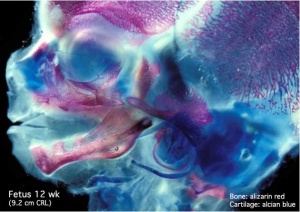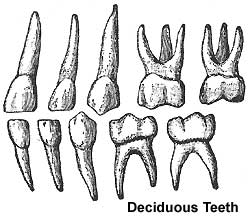2011 Lab 9
Endocrine and Integumentary
| Integumentary Links: integumentary | Lecture | hair | tooth | nail | integumentary gland | mammary gland | vernix caseosa | melanocyte | touch | Eyelid | outer ear | Histology | integumentary abnormalities | Category:Integumentary | |||||||||||
|
|
|
| ||||||||
Endocrine
- Begin by working through Endocrine Development by week 8.
- Then look at the information on each endocrine organ on their related specific page.
| Endocrine Links: Introduction | BGD Lecture | Science Lecture | Lecture Movie | pineal | hypothalamus | pituitary | thyroid | parathyroid | thymus | pancreas | adrenal | endocrine gonad | endocrine placenta | other tissues | Stage 22 | endocrine abnormalities | Hormones | Category:Endocrine | ||
|
Integumentary
| Integumentary Links: integumentary | Lecture | hair | tooth | nail | integumentary gland | mammary gland | vernix caseosa | melanocyte | touch | Eyelid | outer ear | Histology | integumentary abnormalities | Category:Integumentary | |||||||||||
|
|
|
| ||||||||
Teeth
- integumentary system specialization by epitheilal/mesenchymal interactions in development and develops with a major contribution from the neural crest.
- ectoderm of the first pharyngeal arch and neural crest, ectomesenchymal cells.
- week 6 - odontogenesis begins, tooth bud
- 4 morphological stages describing the early tooth development: bud, cap, bell, and terminal differentiation
- 2 sets of teeth: 20 deciduous teeth, 32 permanent teeth
- differential rates of growth, shed at different times over 20 year period
- inductive influence of neural crest with overlying ectoderm
- tooth growth occurs in ossifying jaws
odontoblasts - neural crest-derived mesenchymal cells which differentiate under the influence of the enamel epithelium. Cells secrete predentin, calcifies to form dentin.
ameloblasts - inner enamel epithelium forms pre-ameloblasts differentiate and produce enamel
periodontal ligament - tooth is not anchored directly onto its bony socket (alveolar bone) but held in place by the periodontal ligament (PDL), a specialized connective tissue structure that surrounds the tooth root coating of cementum.
- ligament also act as; a shock absorber, transmitter of chewing forces (from tooth to bone), sensory information (heat, cold, pressure and pain).
- collagen fiber bundles within the ligament are called "Sharpey's fibres".
Tooth Stages
Tooth development stages[1]
| Stage | Human (weeks) | |
| lamina | 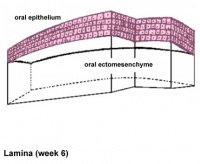
|
Week 6 |
| placode | 
|
Week 7 |
| bud | 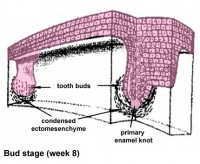
|
Week 8 |
| cap | 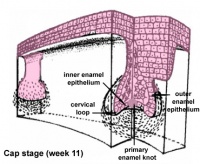
|
Week 11 |
| bell | 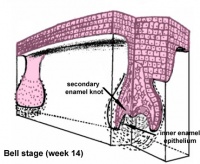
|
Week 14 |
Teeth Postnatal
Deciduous teeth
- 6 - 24 months - erupt from gums by pushing toward surface
- 2 years - all deciduous teeth present
Permanent teeth
- 6 years until early adult
- tooth bud lie in gums beneath deciduous teeth
- osteoclasts resorb deciduous teeth roots
- growth affects face shape
- Links: Tooth Development
Individual Assessment
Group Project
- Peer Assessment of your project should now appear on your group discussion page.
- Now you can make changes to your project based upon these reviews and your own concepts of how the project can be improved.
- At this time it is important that you interact with other group members to ensure they agree on the changes you may make.
- You may add additional content to your project.
- Look through the comments made by your peers and assemble a summary of good (positive) and bad (negative) feedback on your project.
- What are the common features of peer comments?
- Fix those minor problems (formatting, image size, image labelling, text, referencing)
- Are there parts of your project where group members have not worked appropriately or contributed their work?
- I will initially be discussing this with the groups individually. You will also have the opportunity to "feed back" contribution issues.
Plagiarism
Currently all students originally assigned to each group are listed as equal authors/contributors to their project. If you have not contributed the content you had originally agreed to, nor participated in the group work process, then you should contact the course coordinator immediately and either discuss your contribution or request removal from the group author list. Remember that all student online contributions are recorded by date, time and the actual contributed content. A similar email reminder will be sent to all current students.
Please note the Universities Policy regarding Plagiarism
In particular this example:
- "Claiming credit for a proportion of work contributed to a group assessment item that is greater than that actually contributed;"
Academic Misconduct carries penalties. If a student is found guilty of academic misconduct, the penalties include warnings, remedial educative action, being failed in an assignment or excluded from the University for two years.
2011 Projects: Turner Syndrome | DiGeorge Syndrome | Klinefelter's Syndrome | Huntington's Disease | Fragile X Syndrome | Tetralogy of Fallot | Angelman Syndrome | Friedreich's Ataxia | Williams-Beuren Syndrome | Duchenne Muscular Dystrolphy | Cleft Palate and Lip
SOMS Summer Research Awards
- The Research Support Committee is pleased to announce that it will again be offering Summer Research Awards (SRAs).
- These awards are for undergraduate students carrying out supervised research in SOMS between November 2011 and February 2012.
- Successful students will receive $250 per week for 6 weeks of research. More Information?
References
- ↑ <pubmed>19266065</pubmed>| PMCID: PMC2651620
Co-ordinator Note
Dr Mark Hill |
ANAT2341 Embryology S2 2011
|
Course Content 2011
2011 Timetable: | Embryology Introduction | Fertilization | Cell Division/Fertilization | Week 1 and 2 Development | Week 3 Development | Week 1 to 3 | Mesoderm Development | Ectoderm, Early Neural, Neural Crest | Trilaminar Embryo to Early Embryo | Early Vascular Development | Placenta | Vascular and Placenta | Endoderm, Early Gastrointestinal | Respiratory Development | Endoderm and Respiratory | Head Development | Neural Crest Development | Head and Neural Crest | Musculoskeletal Development | Limb Development | Musculoskeletal | Renal Development | Genital | Kidney and Genital | Sensory | Stem Cells | Stem Cells | Endocrine Development | Endocrine | Heart | Integumentary Development | Heart and Integumentary | Fetal | Birth and Revision | Fetal
Glossary Links
- Glossary: A | B | C | D | E | F | G | H | I | J | K | L | M | N | O | P | Q | R | S | T | U | V | W | X | Y | Z | Numbers | Symbols | Term Link
Cite this page: Hill, M.A. (2024, April 24) Embryology 2011 Lab 9. Retrieved from https://embryology.med.unsw.edu.au/embryology/index.php/2011_Lab_9
- © Dr Mark Hill 2024, UNSW Embryology ISBN: 978 0 7334 2609 4 - UNSW CRICOS Provider Code No. 00098G

